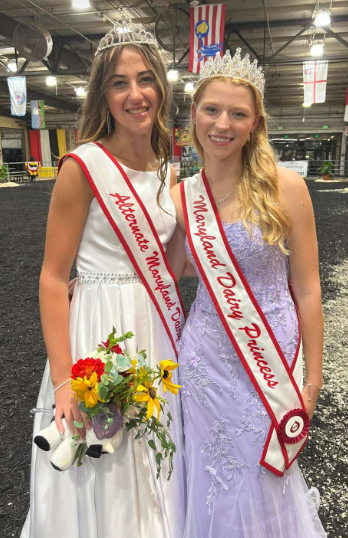North Harford High School is the only school in the county that has barns. “The pig barn has been here for at least 30 years. There was another barn there before that burned down. The horse barn has been here since 2010,”explains agriculture and horticulture teacher Mrs. Aimee Densmore. The pig barn is used for “animal housing, feed and hay storage, [and] equipment storage,” adds Densmore.
Lots of people at NH use the barns. “All of the students who are in Ag 1, Animal Science 1, Animal Science 3, Foundations, or Large Animal Management…and anyone else who asks,” Densmore says. “Students learn about proper care and management of the animals that are housed in the barn, safe birthing areas for lambs and piglets, feed storage, how to stack hay properly, shelter to look at, [and] work on equipment as needed. It is an integral part of animal management and care.”
The barns are a staple at North Harford, and they house all the animals. “The horse barn houses two horses, a donkey, three alpacas, a cow, three sheep, and two rabbits. The pig barn houses a sow and a gilt right now but it can hold 25 [or more] pigs comfortably,” Densmore continues.
In order to prepare for the birth of the piglets, “we are in the process of adding a new farrowing crate and redesigning the inside of the farrowing house, because both pigs are due at the same time this year,” reports the teacher. “We have to have a safe place for each sow/gilt to give birth to ensure the survival of their piglets.”
Pigs give birth to lots of piglets at once. “Imagine having 16 children at one time running around that weigh less than three pounds each; you weigh 400+ pounds, and [you’re] trying to keep track of each child,” elaborates Densmore. With that much weight, pigs are at risk of crushing their babies. “We use the farrowing crates that are designed to give the piglets escape areas so their mom does not lay on them (of course never intentionally) and crush them,” explains Densmore.
Lots of research goes into finding the perfect farrowing crate. “The ag teachers have put a lot of time and effort into finding the right farrowing crate that is adjustable for a larger sow like Ms. Cherry,” says Densmore, “and then figuring out the best way to set both farrowing crates up in the farrowing house (where there is limited space) to ensure the safety of our students and the pigs.”
North Harford takes pride in having an efficient barn system. “As a model program in the State of Maryland, we strive to provide the best care and housing for all of our animals,” says Densmore, “ The addition of the new farrowing crate is following industry standards, so we are showing our students on a much smaller scale, how piglets are born and cared for on any industry farm.”
Industry farms have large amounts of piglets being born at once. “They will have 100+ sows in a barn farrowing at one time…we do not need that, but each sow/gilt here will have her own farrowing crate that gives her piglets the best chance of survival,” explains Densmore.
Many programs rely on the survival of the piglets. “The more piglets that survive, the more students will have the opportunity to show them at the Harford County Farm Fair,” says Densmore.
The money brought in by the farm fair, “brings in money for our Ag Program that supports our FFA members in competitions trips to the Maryland State FFA Convention, trips to the National FFA Convention.” says Densmore.
The money doesn’t just go to supporting the FFA; it also pays for “veterinary bills, supplies and equipment that we need, etc., to enhance our classes or make life better for the animals and students we have here,” finishes Densmore.
















